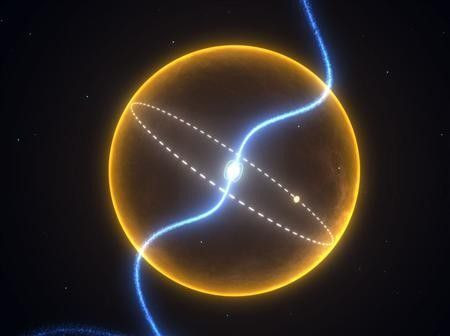Extraordinary ‘Diamond’ Planet 4000 Light Years Away

Diamonds are a girl's best friend. So it might be interesting for ladies to note that astronomers have discovered a dense extrasolar planet that they believe is composed of ultradense diamond. The catch here is that this planet lies 4,000 light years away.
The new planet, with an average density of at least 23 grams per cubic centimeter (or about twice that of lead), is far denser than any other known. Since it may be the remains of a carbon-rich white dwarf star, the object's incredible density subjects it to great internal pressure. The pressure acting on the carbon-rich planet may have crystallized much of it to an ultradense diamond, said scientists.
The evolutionary history and amazing density of the planet all suggest it is comprised of carbon -- i.e. a massive diamond orbiting a neutron star every two hours in an orbit so tight it would fit inside our own Sun, said Matthew Bailes of Swinburne University of Technology in Melbourne.
The planet, about as massive though much denser than Jupiter, was discovered orbiting what's known as a millisecond pulsar. Pulsars are tiny, dead neutron stars that are only around 20 kilometers (12.4 miles) in diameter and spin hundreds times per second, emitting beams of radiation.
In the case of pulsar J1719-1438, the beams regularly sweep the Earth and have been monitored by telescopes in Australia, Britain and Hawaii, allowing astronomers to detect modulations due to the gravitational pull of its unseen companion planet, reports Reuters. The planet orbits the pulsar every two hours and 10 minutes, covering a distance of about 372,822 miles (600,000 kilometers), Bailes and colleagues reported in the journal Science on Thursday.
The planet is the remnant of a once massive star that was cannibalized by the pulsar it orbits. Astronomers estimate that the newfound planet is 34,175 miles (55,000 kilometers) across, or about five times Earth's diameter.
Owing to its high density, lighter elements of hydrogen and helium, which are the main constituents of gas giants like Jupiter, are not present. Besides carbon, the new planet may also contain oxygen, which would be more prevalent on the surface and lesser in the carbon-rich centre, added the Reuters report.
However, scientists are still unclear as to how this diamond planet looks like.
In terms of what it would look like, I don't know I could even speculate, said Ben Stappers of the University of Manchester. I don't imagine that a picture of a very shiny object is what we're looking at here.
© Copyright IBTimes 2025. All rights reserved.





















